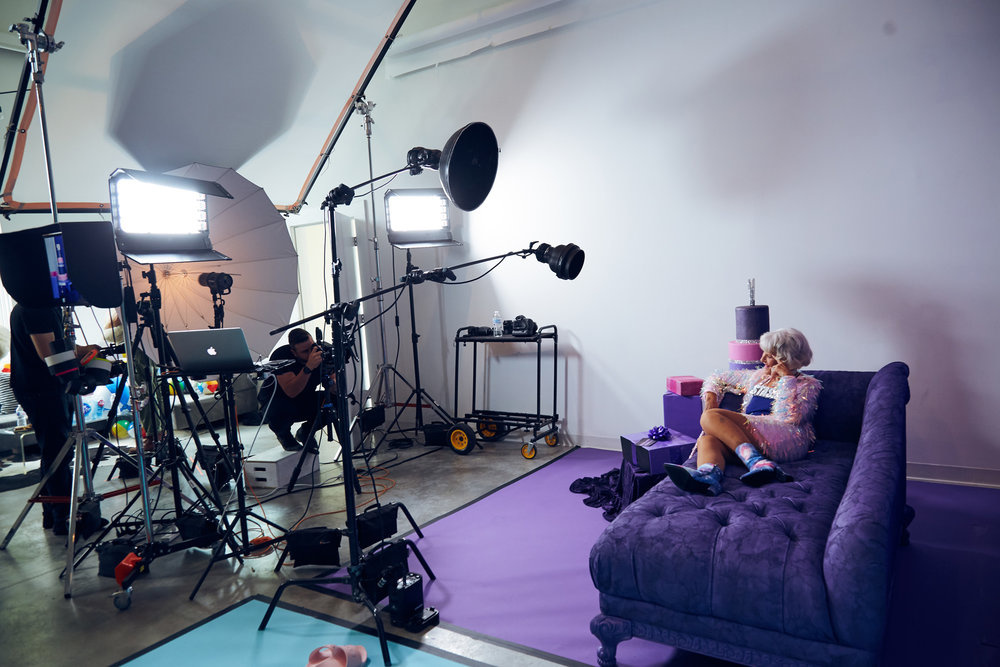Fashion and Editorial Photographer Clay Cook recently partnered with Stash, a mobile investment app, to photograph Instagram personality Baddie Winkle for a retirement themed campaign. I had the opportunity to pull up with Cook to discuss the shoot as well as learn more about how he approaches his business and brand.
When Stash approached Cook with their campaign theme promoting “Your Best Life, Your Whole Life,” which also coincided with celebrating Winkle’s 90th birthday, who rose to fame after her great-granddaughter posted a photo of her in cut-off jean shorts, tie-dyed shirt, and marijuana-themed socks, Cook was all in. The end goal for the project would be two final images which in turn would be used to create murals painted onto the facade of buildings in Brooklyn, New York. Head over to Cook's website to get an in-depth look at his process and vision for the shoot, as well as the gear he used to produce the images.

Chatting with Cook, I asked what his approach was when scoping out projects and if he had any tips for up-and-coming photographers. Cook spoke to his evolving process which has changed over the years, but at this point starts when his executive producer via Wonderful Machine receives an inquiry. The producer will field the bulk of the upfront questions with the potential client. Next, they utilize a production estimation software called BlinkBid to get an idea on production cost for the quote. BlinkBid is cloud-based estimating and production coordination software which offers an easy to use platform with a catalog of industry standard items that is set up to plug-and-play. After the numbers are crunched and the estimate is awarded, Cook takes over on the creative portion and production detail with the team.

Cook and I also spoke about his thoughts on utilizing retouchers. “Retouching is a craft and an art of its own and requires a lot of time, just like a makeup artistry or hair styling,” said Cook. “Most photographers don’t attempt makeup, why should they attempt a retouch?” Cook recommends photographers look to partner with retouchers on their level and build a working relationship from there.

In his Baddie Winkle article, Cook talks about making a large investment into Phase One, so we discussed gear as well. Cook explained that he doesn’t need a Phase One or Profoto lighting to achieve great results, but the more advertising work he does the more the gear helps in building brand value. Cook further explained that the transition really began after a client knew he had used the Phase One system on a previous project, but on the current project Cook had planned to use his Canon 5D Mark III system instead. Feeling that the clients expectations weren’t met by the discussion, Cook decided to make the largest investment of his career with an investment into the quality and value of his brand by adding a Phase One system to his gear. “No camera is perfect, that’s why I’m fortunate enough to have a small selection depending on the project at hand,” Cook said.
Make sure to check out Clay Cook’s “Fashion and Editorial Portrait Photography” tutorial in the Fstoppers store.
Images used with permission of Clay Cook.






![Photographer and Former 'America's Next Top Model' Judge Nigel Barker Launches 'Top Photographer' [Exclusive Interview]](https://cdn.fstoppers.com/styles/small-16-9/s3/lead/2016/08/nigel-barker-fstoppers-interview.jpg)
Clay is the man, and his tutorial series was one of the best investments I've made in my photography. Loved his BTS post on working with Baddie.
I expected extraordinary result from all these gears and setup. Looking at the result though I really think its an overkill and didn’t do its justice. What’s more interesting is the end result and its IQ has nothing to do with the painting on the building.